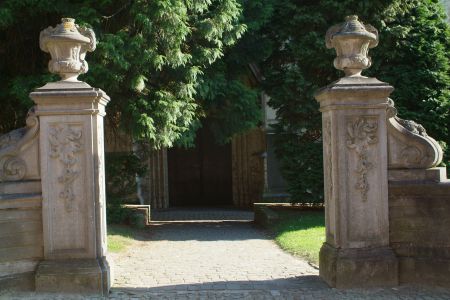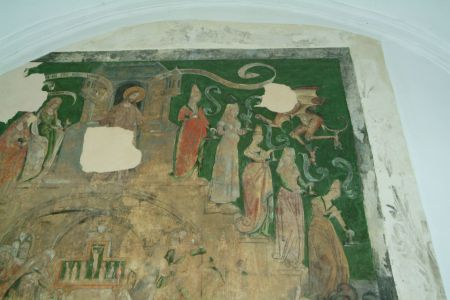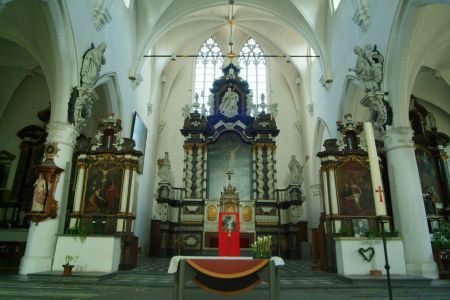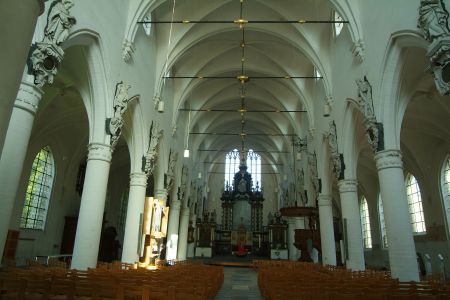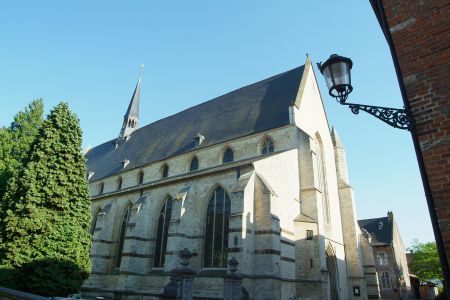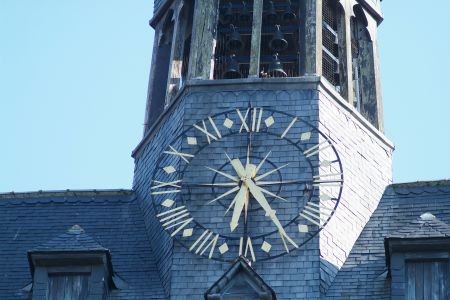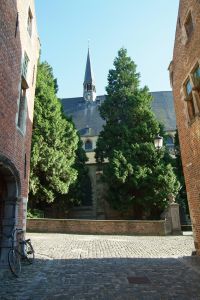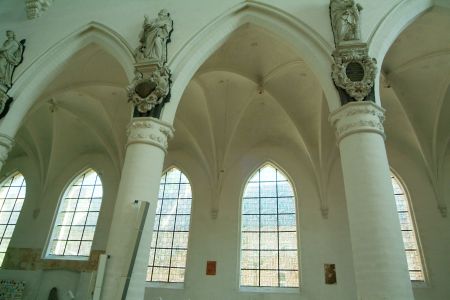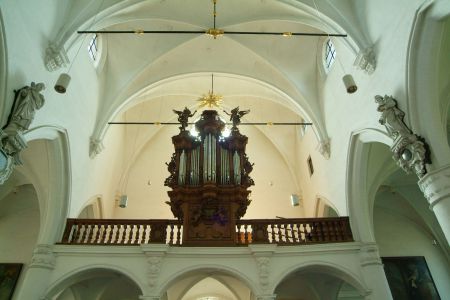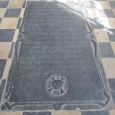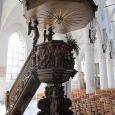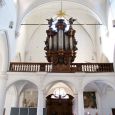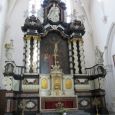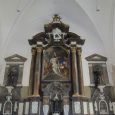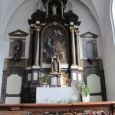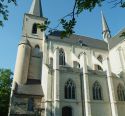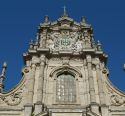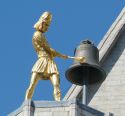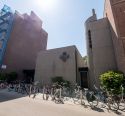Church | XIII-XV | Gothic | Catholic Church


Map
Opening hours
01 April - 30 September
Mon -
Tue 13.30 - 16.30
Wed 13.30 - 16.30
Thu 13.30 - 16.30
Fri 13.30 - 16.30
Sat -
Sun -
Religious offices
Sunday 11 am
Description
Founded in the 13th century, the “Grand Beguinage” (UNESCO heritage site) was bought by the University of Louvain in 1962 and made into students’ halls of residence.
In the midst of its narrow alleys the primitive Gothic church (14th century) is dedicated to Saint John the Baptist. Designed like a basilica it has neither tower nor transept. The huge stained glass window of the chevet (extreme end of the chancel) attracts immediate attention.
Above the altar is a “Golgotha” by Pieter Josef Verhaeghen. The altars and the confessionals are 16th century and the organ (1692) is by Pieter Goltfuss. Thanks to restoration work, frescoes of the 14th 15th and 17th centuries have been discovered and 90 tombstones of beguines* uncovered on the floor.
*Beguines did not make solemn vows like nuns but promised to be chaste for the time of their stay at the beguinage and to obey the ecclesiastic authority of their superiors, called “Grandes Dames”. The beguines filled their day with religious observance, the education of young girls, needle work or nursing the sick.
KIKIRPA : Photo-library online
Photos
Media
Remarkable elements
Tombs
Around 90 tombstones can be found spread over the whole floor of the church. They belong to priests and Beguines that were buried between 1396 and 1753. It was a privilege of the rich to be buried here. The tombstones of the four Steuckers sisters and their niece Maria van Rivieren can be found in the right aisle. There are two tombstones on the left and right side of the confessional in the left aisle with an exceptional art historical value. They belong to Katherine van Voirsselaer (+1458) and Katherine van Nethenen (+1459), both Beguines in Leuven. The inscriptions were written in Gothic letters. Originally these tombstones were part of the floor of the church. In front of the altar, in the middle, there is a tombstone of ‘Damoiselle Thérèse Philippine Van Spoelberch, issue des familles de Spoelberch et de Dielbeeck’. The de Spoelberch family is one of the richest families in Belgium. They are active in the brewing industry, among others, through the AB Inbev group and the Stella brewery.Murals
Several murals from the 14th and the 17th century were found during restoration works. They were hidden underneath several layers of plaster and whitewash. Research showed that it were murals (and not frescoes), since they were applied on dry plaster. A 14th century fragment of the Holy Veronica with an angel can be found in the right aisle. It originally came from the now bricked southern portal. Scenes of the lives of saints (mainly in yellow and ochre), a floral pattern and a baptism scene can also be seen in the same aisle. A 15th century mural of the parable of the wise and the foolish virgins can be found in the left aisle. Stylistically it belongs to the ‘Boutsgroup’ with Burgundian dresses and coiffure. The scene was inspired on a presentation of the same theme in ‘Speculum Humanae Savatoris’ (Mirror of Human Salvation), an illustrated book from the same period.Pulpit
The year the oak pulpit was built is engraved on the back of the stairs (anno 1661). The pulpit is carried by four lion paws and by angels. There are four cartouches with reliefs on the octagonal tub. They represent Saint John the Baptist, Our Lady with Child, Saint John Evangelist and Saint Begga. On the corners are the four Western Fathers with their attributes: Saint Jerome with a lion, Saint Ambrose with a beehive, Saint Gregory with a tiara and Saint Augustine (without attributes). On top of the pulpit is a dove carried by angels, symbolising the Holy Spirit. The staircase is decorated with leafs and fruit motifs.Monumental organ
There is a monumental organ on the rood screen that was made, according to the chronogram on the cartouche, in 1692. It is the only remaining organ by Pieter Goltfuss, eldest son of Hans Golftuss, who moved from Germany to Haacht. It is a beautiful, well-built and well-proportioned oak piece of furniture with an interior that is constructed pyramidal. The instrument is designed as a balustrade organ with the keyboard on the back. It is one of the best-kept organs from the 17th century and has a very high artistic value. This is also a very interesting organ for music history: the pipes produce a very pure sound. The sound is therefore a perfect representation of the 17th century organ culture, an important century for Flemish organ art.Main altar
At the centre of the portico altar in the choir hangs the painting of “Christ on the Cross” by Pieter Jozef Verhaegen. There are statues on either side of the altar. Saint Begga (with the monastery of Andenne) and Saint Gertrude (with staff). Busts of Saint John and Saint Adrian can be found underneath these ladies. The statue in the central niche on top depicts God the Father. The paintings “Presentation of Jesus in the Temple” (on the right) and “The Child Jesus among the scribes” (on the left) hang on the sidewalls of the choir.Left side altar
This portico altar (circa 1654) with four Corinthian columns is dedicated to Our Lady of seven sorrows. An angel on top is holding the canopy of Veronica. The painting “The Descent” by Caspar De Crayer hangs in the centre. There are two reliquaries: Saint Apollonia and the Holy Cross on the right and left base of the altar. Above these reliquaries stand two statues, one of Saint Anthony of Padua (18th century) and one of Saint Roch (17th century). A statue of Saint Begga (19th century) stands in the middle on the altar. There is an elongated niche in the wall on the left. The statue “Christ in the grave” (1500) used to be there. At the moment it is on display in M Museum.Right side altar
This portico altar with four Corinthian columns is dedicated to Our Lady, Saint Joseph and Saint Francis. The painting “Return of the flight to Egypt” hangs in the centre. A statue of Saint John the Baptist stands on the left of the canvas. The statue in the right niche has disappeared. Depicted on the medallion at the top is an angel telling Mary that she will be the mother of God’s son. A statue of Our Lady with child in a Spanish dress with a silver crown stands in the centre on the altar. In front of the altar stands a beautiful carved wood communion with tendrils, corn ears, grape bunches and two medallions with Eucharistic symbols.University parish
The church is currently used for masses of the university parish. They welcome visitors: Every society, and most definitely the complex, multi-cultural and religious society in which we live, needs thinkers, doers and dreamers who make living together a humane and inspired context. It is part of the UP’s mission to offer opportunities to students, staff, alumni and emeriti to be inspired and to confirm.UP wants to be a place where people with an open mind can ask questions about meaning, both intellectual and existential. UP aims to provide opportunities for a founded conversation, debate or personal development. The training programs on spirituality aim to meet this mission. UP offers an extensive range of training programs, from lectures and workshops to weekends and discussion groups.



